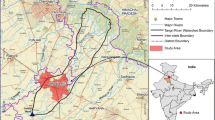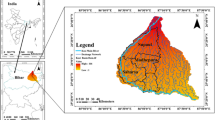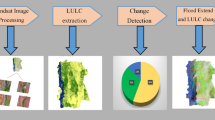Abstract
This study is an effort of geo-spatial assessment of pluvial floods in District Lahore, Pakistan, caused by urban expansion and the growing frequency and intensity of high-intensity rainfall events. The use of geospatial techniques such as watershed modeling, maximum likelihood image classification, and weighted overlay analysis based on secondary data has enabled the researchers to assess the extent and severity of pluvial floods in the study area. The study’s findings highlight the high risk of pluvial floods in the central part of the study area, which is dominated by built-up land and concrete roads. The increase in the area of built-up land from 34.913 km2 in 2018 to 37.442 km2 in 2022 has further intensified the risk of pluvial floods. The findings of this study can assist policymakers in develo** effective strategies to reduce the risks associated with pluvial floods. Alongside, it also highlights the importance of geospatial techniques to better understand and address the complex challenges of urbanization and climate change. Flood risk zone-specific strategies are recommended to reduce the risk of pluvial floods.











Similar content being viewed by others
Data availability
Data will be made available on request.
References
Akhtar, S., & Dahnani, M. (2012). Surface water drainage and flooding in Karachi city. Sindh University Research Journal-SURJ (Science Series), 44(1).
Ali, A., Mahmood, K., Bashir, H., Qaiser, S., & Yousaf, S. (2018). Assessment of urban floods in Lahore using geospatial techniques. Journal of Geoscience and Environment Protection, 6(2), 34–48. https://doi.org/10.4236/gep.2018.62003
Ali, M., Tariq, S., Mahmood, K., Daud, A., Batool, A., & Zia ul, H. (2014). A study of aerosol properties over Lahore (Pakistan) by using AERONET data. Asia-Pacific Journal of Atmospheric Sciences, 50(2), 153–162.
Ali, M. I., Dirawan, G. D., Hasim, A. H., & Abidin, M. R. (2019). Detection of changes in surface water bodies urban area with NDWI and MNDWI methods. International Journal on Advanced Science Engineering Information Technology, 9(3), 946–951.
Ali, S., Basit, A., Makanda, T. A., Inamullah, Khan, F. U., Sajid, M., et al. (2023). Improving drought mitigation strategies and disaster risk reduction through MODIS and TRMM-based data in relation to climate change over Pakistan. Environmental Science and Pollution Research, 30(14), 40563–40575.
Bag, S., Rahman, M. S., Rogers, H., Srivastava, G., & Pretorius, J. H. C. (2023). Climate change adaptation and disaster risk reduction in the garment industry supply chain network. Transportation Research Part E: Logistics and Transportation Review, 171, 103031.
Bourget, M., Boudreault, M., Carozza, D. A., Boudreault, J., & Raymond, S. (2023). Future insurance losses for pluvial flooding in Canada and the United States. Cambridge Default Journal, 20, 1–20.
Dillenardt, L., Hudson, P., & Thieken, A. H. (2022). Urban pluvial flood adaptation: Results of a household survey across four German municipalities. Journal of Flood Risk Management, 15(3), e12748.
Dutta, D., Rahman, A., Paul, S. K., & Kundu, A. (2021). Impervious surface growth and its inter-relationship with vegetation cover and land surface temperature in peri-urban areas of Delhi. Urban Climate, 37, 100799.
Duya, M. A., Pagulayan, R. C., Carandang, J. A., & De Guzman, R. M. (2021). Fluvial flood risk analysis and map** for a coastal river basin in the Philippines. Applied Sciences, 11(3), 1223. https://doi.org/10.3390/app11031223
Farooq, S., Ali, Z., & Arshad, M. N. (2018). Spatial analysis of flooding in Lahore: A geospatial approach. Journal of Water and Climate Change, 9(3), 536–547. https://doi.org/10.2166/wcc.2017.157
Fowler, H. J., Lenderink, G., Prein, A. F., Westra, S., Allan, R. P., Ban, N., et al. (2021). Anthropogenic intensification of short-duration rainfall extremes. Nature Reviews Earth & Environment, 2(2), 107–122.
Galarraga, D., & Liria, P. (2018). Resilience assessment of fluvial flood risk management strategies in urban areas. Water, 10(11), 1597. https://doi.org/10.3390/w10111597
Gull, A., & Mahmood, S. (2022). Spatio-temporal analysis and trend prediction of land cover changes using Markov chain model in Islamabad, Pakistan. Advanced GIS, 2(2), 52–62.
Iftikhar, Z., Ahmad, S., & Abbas, M. (2020). Geospatial assessment of urban floods in Lahore. Water, 12(1), 134. https://doi.org/10.3390/w12010134
Kreibich, H., Seifert, I., Merz, B., & Thieken, A. (2015). Probabilistic forecasting of fluvial floods: Application to the river Rhine at Cologne, Germany. Journal of Hydrology, 529, 1434–1443. https://doi.org/10.1016/j.jhydrol.2015.08.063
Kundzewicz, Z. W., & Pińskwar, I. (2022). Are pluvial and fluvial floods on the rise? Water, 14(17), 2612.
Liang, Y., Jiang, C., Ma, L., Liu, L., Chen, W., & Liu, L. (2017). Government support, social capital and adaptation to urban flooding by residents in the Pearl River Delta area, China. Habitat International, 59, 21–31.
Liu, Y., Chen, J., Chen, Y., Wang, W., Wu, Q., & Yu, X. (2020). Analysis of urban flood control systems for reducing flood risks in a fluvial city. Water, 12(6), 1701. https://doi.org/10.3390/w12061701
Mahmood, A., Nasreen, S., Nawaz, M. A., Khalid, A., & Ali, A. (2019). Assessment of urban floods in Lahore city using remote sensing and GIS techniques. Journal of the Indian Society of Remote Sensing, 47(7), 1199–1209. https://doi.org/10.1007/s12524-019-01032-1
Mahmood, S. (2019). Flood risk modelling and management in Panjkora Basin, Eastern Hindu Kush, Pakistan (Doctoral dissertation. University of Peshawar.
Mahmood, S., & Hamayon, K. (2021). Geo-spatial assessment of community vulnerability to flood along the Ravi River, Ravi Town, Lahore, Pakistan. Natural Hazards, 1–20.
Mahmood, S., & Rahman, A. (2019). Flash flood susceptibility modelling using geo-morphometric approach in Ushairy Basin, Eastern Hindu Kush. Journal of Earth System Science, 128(4), 97–111.
Mahmood, S., & Rani, R. (2022). People-centric geo-spatial exposure and damage assessment of 2014 flood in lower Chenab Basin, upper Indus Plain in Pakistan. Natural Hazards, 111(3), 3053–3069.
Majumder, S., Roy, S., Bose, A., & Chowdhury, I. R. (2023). Multiscale GIS based-model to assess urban social vulnerability and associated risk: Evidence from 146 urban centers of Eastern India. Sustainable Cities and Society, 104692.
Raza, A., Shafique, M., Nawaz, M., & Nasim, W. (2016). Urban flood hazard map** using remote sensing and GIS techniques: A case study of Lahore City, Pakistan. Water, 8(9), 373. https://doi.org/10.3390/w8090373
Roy, S., Bose, A., Basak, D., & Chowdhury, I. R. (2023). Towards sustainable society: The sustainable livelihood security (SLS) approach for prioritizing development and understanding sustainability: an insight from West Bengal, India. Environment, Development and Sustainability, 1–32.
Roy, S., Bose, A., & Chowdhury, I. R. (2021a). Flood risk assessment using geospatial data and multi-criteria decision approach: A study from historically active flood-prone region of Himalayan foothill, India. Arabian Journal of Geosciences, 14(11), 999.
Roy, S., Bose, A., Majumder, S., Roy Chowdhury, I., Abdo, H. G., Almohamad, H., Al Dughairi, A., & A. (2022). Evaluating urban environment quality (UEQ) for Class-I Indian city: an integrated RS-GIS based exploratory spatial analysis. Geocarto International, 2153932.
Roy, S., Bose, A., Singha, N., Basak, D., & Chowdhury, I. R. (2021b). Urban waterlogging risk as an undervalued environmental challenge: An integrated MCDA-GIS based modeling approach. Environmental Challenges, 4, 100194.
Roy, S., Majumder, S., Bose, A., & Roy Chowdhury, I. (2023). Does geographical heterogeneity influence urban quality of life? A case of densely populated Indian City. Papers in Applied Geography, (just-accepted, 1–29.
Saeed, A., Zafar, M. A., Shabbir, R., & Khan, S. (2021). Analysis of flash floods in urban Lahore. Natural Hazards Review, 22(1), 04020029. https://doi.org/10.1061/(asce)nh.1527-6996.0000375
Salem, M., Bose, A., Bashir, B., Basak, D., Roy, S., Chowdhury, I. R., et al. (2021). Urban expansion simulation based on various driving factors using a logistic regression model: Delhi as a case study. Sustainability, 13(19), 10805.
Siraj, M., Mahmood, S., & Habib, W. (2023). Geo-spatial assessment of land cover change in District Dera Ismail Khan, Khyber Pakhtunkhwa, Pakistan. Advanced Remote Sensing, 3(1), 1–9.
Sultana, S., Khan, M. B., Hameed, B., & Tayyab, M. (2020). Urban flood risk map** using hydrological modeling and geospatial techniques. Geomatics, Natural Hazards and Risk, 11(1), 883–898. https://doi.org/10.1080/19475705.2020.1749783
Vorobevskii, I., Al Janabi, F., Schneebeck, F., Bellera, J., & Krebs, P. (2020). Urban floods: Linking the overloading of a storm water sewer system to precipitation parameters. Hydrology, 7(2), 35.
Zhang, X., Gharabaghi, B., Rudra, R., & Chen, Z. (2018). Effects of urbanization on fluvial flood frequency and magnitude in the Greater Toronto Area, Canada. Journal of Hydrology, 556, 469–481. https://doi.org/10.1016/j.jhydrol.2017.11.024
Zia, S., & Shirazi, S. A. (2019). Spatio-temporal analysis of areas vulnerable to urban flooding: A case study of Lahore, Pakistan. International Journal of Economic and Environmental Geology, 10(3), 85–89.
Zia, S., Shirazi, S. A., Nasar-u-Minallah, M., & Batool, M. (2021). Urban floods and suitability analysis of rainwater harvesting potential areas in Lahore City, Pakistan. International Journal of Economic and Environmental Geology, 12(2), 13–20.
Acknowledgements
We acknowledge online data sources for providing this opportunity to conduct research studies.
Author information
Authors and Affiliations
Contributions
Ali and Mahmood contributed equally to the study conception and design of the study. Material preparation, data collection and analysis were performed by Ali and Mahmood supervised, reviewed and updated the manuscript.
Corresponding author
Ethics declarations
Competing interests
The authors declare no competing interests.
Ethics approval
No ethical approval is required for this study.
Ethical responsibilities of authors
All authors have read, understood, and have complied as applicable with the statement on “The manuscript is not be submitted to any other journal nor under consideration. All the data, results, and maps produced have been prepared in this study.”
Additional information
Publisher’s Note
Springer Nature remains neutral with regard to jurisdictional claims in published maps and institutional affiliations.
Rights and permissions
Springer Nature or its licensor (e.g. a society or other partner) holds exclusive rights to this article under a publishing agreement with the author(s) or other rightsholder(s); author self-archiving of the accepted manuscript version of this article is solely governed by the terms of such publishing agreement and applicable law.
About this article
Cite this article
Ali, M., Mahmood, S. Geo-spatial assessment of pluvial floods in city district Lahore, Pakistan. Environ Monit Assess 196, 189 (2024). https://doi.org/10.1007/s10661-023-12291-6
Received:
Accepted:
Published:
DOI: https://doi.org/10.1007/s10661-023-12291-6




